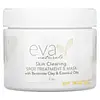What's inside
What's inside
 Key Ingredients
Key Ingredients

 Benefits
Benefits

 Concerns
Concerns

 Ingredients Side-by-side
Ingredients Side-by-side

Water
Skin ConditioningKaolin
AbrasiveBentonite
AbsorbentHamamelis Virginiana Water
AstringentAloe Barbadensis Leaf Juice
Skin ConditioningMagnesium Aluminum Silicate
AbsorbentSodium Magnesium Silicate
Citrus Limon Fruit Oil
AstringentCitrus Paradisi Peel Oil
MaskingMelaleuca Alternifolia Leaf Oil
AntioxidantMentha Piperita Oil
MaskingMentha Spicata Herb Oil
PerfumingCitric Acid
BufferingPhenoxyethanol
PreservativeEthylhexylglycerin
Skin ConditioningWater, Kaolin, Bentonite, Hamamelis Virginiana Water, Aloe Barbadensis Leaf Juice, Magnesium Aluminum Silicate, Sodium Magnesium Silicate, Citrus Limon Fruit Oil, Citrus Paradisi Peel Oil, Melaleuca Alternifolia Leaf Oil, Mentha Piperita Oil, Mentha Spicata Herb Oil, Citric Acid, Phenoxyethanol, Ethylhexylglycerin
Kaolin
AbrasiveWater
Skin ConditioningBentonite
AbsorbentAloe Barbadensis Leaf Juice
Skin ConditioningTerminalia Ferdinandiana Fruit Extract
AntioxidantCentipeda Cunninghamii Extract
Skin ConditioningGlycyrrhiza Glabra Root Extract
BleachingRetinyl Palmitate
Skin ConditioningTocopheryl Acetate
AntioxidantUndaria Pinnatifida Extract
Skin ConditioningHamamelis Virginiana Bark/Twig Extract
AstringentPunica Granatum Sterols
Skin ConditioningGarcinia Mangostana Fruit Extract
Skin ConditioningRosmarinus Officinalis Leaf Extract
AntimicrobialPhenoxyethanol
PreservativeDehydroacetic Acid
PreservativeLactic Acid
BufferingCI 77491
Cosmetic ColorantParfum
MaskingGlycerin
HumectantBenzyl Alcohol
PerfumingLimonene
PerfumingKaolin, Water, Bentonite, Aloe Barbadensis Leaf Juice, Terminalia Ferdinandiana Fruit Extract, Centipeda Cunninghamii Extract, Glycyrrhiza Glabra Root Extract, Retinyl Palmitate, Tocopheryl Acetate, Undaria Pinnatifida Extract, Hamamelis Virginiana Bark/Twig Extract, Punica Granatum Sterols, Garcinia Mangostana Fruit Extract, Rosmarinus Officinalis Leaf Extract, Phenoxyethanol, Dehydroacetic Acid, Lactic Acid, CI 77491, Parfum, Glycerin, Benzyl Alcohol, Limonene
Ingredients Explained
These ingredients are found in both products.
Ingredients higher up in an ingredient list are typically present in a larger amount.
Aloe Barbadensis Leaf Juice comes from leaves of the aloe plant. Aloe Barbadensis Leaf Juice is best known for helping to soothe sunburns. It is also anti-inflammatory, moisturizing, antiseptic, and can help heal wounds.
Aloe is packed with good stuff including Vitamins A, C, and E. These vitamins are antioxidants, which help fight free-radicals and the damage they may cause. Free-radicals are molecules that may damage your skin cells, such as pollution.
Aloe Barbadensis Leaf Juice also contains sugars. These sugars come in the form of monosaccharides and polysaccharides, folic acid, and choline. These sugars are able to help bind moisture to skin.
It also contains minerals such as calcium, 12 anthraquinones, fatty acids, amino acids, and Vitamin B12.
Learn more about Aloe Barbadensis Leaf JuiceBentonite is an aluminium phyllosilicate clay with great absorbent properties. The name 'bentonite' comes from the area where the largest source is found: Fort Benton, Wyoming.
As a clay, bentonite is often used to absorb excess oil and provide exfoliation. It has also been shown to have some antibacterial and anti-inflammatory properties. Studies show bentonite was effective at calming dermatitis from poison ivy and in diaper dermatitis of infants. Bentonite has also been shown to act as a barrier against toxic compounds on your skin.
Sunscreens containing bentonite display higher water resistance and stay on the skin for much longer. The sunscreens containing bentonite also show higher potency and UV light absorbtion.
Bentonite is naturally created from volcanic ash and several natural weathering/hydrothermal processes.
A common usage of bentonite is removing excess protein from white wines. Bentonite contains a property of being able to absorb large amounts of protein from aqueous solutions.
Phyllosilicate clay has a structure formed by sheets.
Learn more about BentoniteKaolin is a clay. It is used for oil control and to help minimize pores. Like other clays, kaolin has the ability to absorb excess sebum or oil. This can help clean out pores and mattify the skin.
Some types of kaolin may have exfoliating properties. When water is added to kaolin, it becomes a paste with small abrasive particles.
Most kaolin is a white color, but may be pink/orange/red depending on where it comes from.
The name 'kaolin' comes from a Chinese village named 'Gaoling'. Kaolin clay comes from rocks rich in kaolinite. Kaolinite, the mineral, has a silicate layered structure. Kaolinite is formed from chemical weathering of aluminum siilicate minerals.
Besides skincare, kaolin is commonly used to make glossy paper, in ceramics, toothpaste, and as medicine to soothe stomach issues.
Learn more about KaolinPhenoxyethanol is a preservative that has germicide, antimicrobial, and aromatic properties. Studies show that phenoxyethanol can prevent microbial growth. By itself, it has a scent that is similar to that of a rose.
It's often used in formulations along with Caprylyl Glycol to preserve the shelf life of products.
Water. It's the most common cosmetic ingredient of all. You'll usually see it at the top of ingredient lists, meaning that it makes up the largest part of the product.
So why is it so popular? Water most often acts as a solvent - this means that it helps dissolve other ingredients into the formulation.
You'll also recognize water as that liquid we all need to stay alive. If you see this, drink a glass of water. Stay hydrated!
Learn more about Water